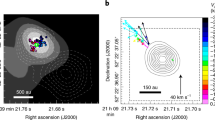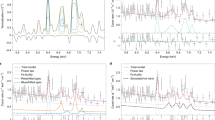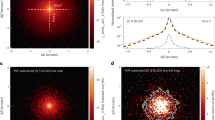Abstract
The accretion of matter onto black holes and neutron stars often leads to the launching of outflows that can greatly affect the environments surrounding the compact object. An important means of studying these winds is through X-ray absorption line spectroscopy, which allows us to probe their properties along a single sightline, but usually provides little information about the global three-dimensional wind structure, which is vital for understanding the launching mechanism and total wind energy budget. Here, we study Hercules X-1, a nearly edge-on X-ray binary with a warped accretion disk precessing with a period of about 35 d. This disk precession results in changing sightlines towards the neutron star, through the ionized outflow. We perform time-resolved X-ray spectroscopy over the precession phase and detect a strong decrease in the wind column density by three orders of magnitude as our sightline progressively samples the wind at greater heights above the accretion disk. The wind becomes clumpier as it rises upwards and expands away from the neutron star. Modelling the warped disk shape, we create a two-dimensional map of wind properties. This measurement of the vertical structure of an accretion disk wind allows direct comparisons with three-dimensional global simulations to reveal the outflow launching mechanism.
This is a preview of subscription content, access via your institution
Access options
Access Nature and 54 other Nature Portfolio journals
Get Nature+, our best-value online-access subscription
$29.99 / 30 days
cancel any time
Subscribe to this journal
Receive 12 digital issues and online access to articles
$119.00 per year
only $9.92 per issue
Buy this article
- Purchase on Springer Link
- Instant access to full article PDF
Prices may be subject to local taxes which are calculated during checkout




Similar content being viewed by others
Data availability
All XMM-Newton data are available publicly at nxsa.esac.esa.int/nxsa-web. All Chandra data are available publicly at tgcat.mit.edu.
Code availability
XMM-Newton data were reduced using the XMM SAS software and Chandra data were reduced using the CIAO software. All spectra were analysed using the spectral fitting package SPEX. All figures except Fig. 1 and Supplementary Fig. 3 were made in VEUSZ, a Python-based scientific plotting package, developed by Jeremy Sanders and available at veusz.github.io.
References
Tombesi, F. et al. Evidence for ultra-fast outflows in radio-quiet AGNs. I. Detection and statistical incidence of Fe K-shell absorption lines. Astron. Astrophys. 521, A57 (2010).
Ueda, Y., Murakami, H., Yamaoka, K., Dotani, T. & Ebisawa, K. Chandra high-resolution spectroscopy of the absorption-line features in the low-mass X-ray binary GX 13+1. Astrophys. J. 609, 325–334 (2004).
Neilsen, J. & Lee, J. C. Accretion disk winds as the jet suppression mechanism in the microquasar GRS 1915+105. Nature 458, 481–484 (2009).
Pinto, C., Middleton, M. J. & Fabian, A. C. Resolved atomic lines reveal outflows in two ultraluminous X-ray sources. Nature 533, 64–67 (2016).
Shakura, N. I. & Sunyaev, R. A. Black holes in binary systems. Observational appearance. Astron. Astrophys. 24, 337–355 (1973).
Proga, D., Stone, J. M. & Kallman, T. R. Dynamics of line-driven disk winds in active galactic nuclei. Astrophys. J. 543, 686–696 (2000).
Blandford, R. D. & Payne, D. G. Hydromagnetic flows from accretion disks and the production of radio jets. Mon. Not. R. Astron. Soc. 199, 883–903 (1982).
Begelman, M. C., McKee, C. F. & Shields, G. A. Compton heated winds and coronae above accretion disks. I. Dynamics. Astrophys. J. 271, 70–88 (1983).
Kosec, P. et al. An ionized accretion disc wind in Hercules X-1. Mon. Not. R. Astron. Soc. 491, 3730–3750 (2020).
Giacconi, R. et al. The Uhuru catalog of X-ray sources. Astrophys. J. 178, 281–308 (1972).
Tananbaum, H. et al. Discovery of a periodic pulsating binary X-ray source in Hercules from Uhuru. Astrophys. J. Lett. 174, L143 (1972).
Roberts, W. J. A slaved disk model for Hercules X-1. Astrophys. J. 187, 575–584 (1974).
Petterson, J. A. Hercules X-1: a neutron star with a twisted accretion disk? Astrophys. J. Lett. 201, L61–L64 (1975).
Gerend, D. & Boynton, P. E. Optical clues to the nature of Hercules X-1/HZ Herculis. Astrophys. J. 209, 562–573 (1976).
Katz, J. I. Thirty-five-day periodicity in Her X-1. Nat. Phys. Sci. 246, 87–89 (1973).
Ponti, G. et al. Ubiquitous equatorial accretion disc winds in black hole soft states. Mon. Not. R. Astron. Soc. 422, L11–L15 (2012).
Nixon, C. J. & Pringle, J. E. Strong surface outflows on accretion discs. Astron. Astrophys. 636, A34 (2020).
Leahy, D. A. & Abdallah, M. H. HZ Her: stellar radius from X-ray eclipse observations, evolutionary state, and a new distance. Astrophys. J. 793, 79 (2014).
Psaradaki, I., Costantini, E., Mehdipour, M. & Díaz Trigo, M. Modelling the disc atmosphere of the low mass X-ray binary EXO 0748-676. Astron. Astrophys. 620, A129 (2018).
Miller, J. M. et al. The magnetic nature of disk accretion onto black holes. Nature 441, 953–955 (2006).
Lang, F. L. et al. Discovery of a 30.5 day periodicity in LMC X-4. Astrophys. J. Lett. 246, L21–L25 (1981).
Wojdowski, P., Clark, G. W., Levine, A. M., Woo, J. W. & Zhang, S. N. Quasi-periodic occultation by a precessing acretion disk and other variabilities of SMC X-1. Astrophys. J. 502, 253–264 (1998).
Jansen, F. et al. XMM-Newton observatory. I. The spacecraft and operations. Astron. Astrophys. 365, L1–L6 (2001).
Weisskopf, M. C. et al. An overview of the performance and scientific results from the Chandra X-Ray Observatory. Publ. Astron. Soc. Pac. 114, 1–24 (2002).
Kosec, P. et al. The long stare at Hercules X-1. I. Emission lines from the outer disk, the magnetosphere boundary, and the accretion curtain. Astrophys. J. 936, 185 (2022).
Reynolds, A. P. et al. A new mass estimate for Hercules X-1. Mon. Not. R. Astron. Soc. 288, 43–52 (1997).
Deeter, J. E., Boynton, P. E. & Pravdo, S. H. Pulse-timing observations of HER X-1. Astrophys. J. 247, 1003–1012 (1981).
den Herder, J. W. et al. The reflection grating spectrometer on board XMM-Newton. Astron. Astrophys. 365, L7–L17 (2001).
Strüder, L. et al. The European Photon Imaging Camera on XMM-Newton: the pn-CCD camera. Astron. Astrophys. 365, L18–L26 (2001).
Canizares, C. R. et al. The Chandra High-Energy Transmission Grating: design, fabrication, ground calibration, and 5 years in flight. Publ. Astron. Soc. Pac. 117, 1144–1171 (2005).
Kaastra, J. S., Mewe, R. & Nieuwenhuijzen, H. in UV and X-ray Spectroscopy of Astrophysical and LaboratoryPlasmas (eds Yamashita K. & WatanabeT.) 411–414 (Universal Academy Press, 1996).
Cash, W. Parameter estimation in astronomy through application of the likelihood ratio. Astrophys. J. 228, 939–947 (1979).
Titarchuk, L. Generalized Comptonization models and application to the recent high-energy observations. Astrophys. J. 434, 570–586 (1994).
Lamb, F. K., Pethick, C. J. & Pines, D. A model for compact X-ray sources: accretion by rotating magnetic stars. Astrophys. J. 184, 271–290 (1973).
Ghosh, P. & Lamb, F. K. Accretion by rotating magnetic neutron stars. II. Radial and vertical structure of the transition zone in disk accretion. Astrophys. J. 232, 259–276 (1979).
Hickox, R. C., Narayan, R. & Kallman, T. R. Origin of the soft excess in X-ray pulsars. Astrophys. J. 614, 881–896 (2004).
Fürst, F. et al. The smooth cyclotron line in Her X-1 as seen with Nuclear Spectroscopic Telescope Array. Astrophys. J. 779, 69 (2013).
Miller, J. M. et al. Flows of X-ray gas reveal the disruption of a star by a massive black hole. Nature 526, 542–545 (2015).
Mehdipour, M., Kaastra, J. S. & Kallman, T. Systematic comparison of photoionised plasma codes with application to spectroscopic studies of AGN in X-rays. Astron. Astrophys. 596, A65 (2016).
HI4PI Collaborationet al. HI4PI: a full-sky H i survey based on EBHIS and GASS. Astron. Astrophys. 594, A116 (2016).
Boroson, B. et al. Hopkins Ultraviolet Telescope observations of Hercules X-1. Astrophys. J. 491, 903–909 (1997).
Jimenez-Garate, M. A., Hailey, C. J., den Herder, J. W., Zane, S. & Ramsay, G. High-resolution X-ray spectroscopy of Hercules X-1 with the XMM-Newton reflection grating spectrometer: CNO element abundance measurements and density diagnostics of a photoionized plasma. Astrophys. J. 578, 391–404 (2002).
Jimenez-Garate, M. A., Raymond, J. C., Liedahl, D. A. & Hailey, C. J. Identification of an extended accretion disk corona in the Hercules X-1 low state: moderate optical depth, precise density determination, and verification of CNO abundances. Astrophys. J. 625, 931–950 (2005).
Raymond, J. C. A model of an X-ray-illuminated accretion disk and corona. Astrophys. J. 412, 267–277 (1993).
Przybilla, N., Firnstein, M., Nieva, M. F., Meynet, G. & Maeder, A. Mixing of CNO-cycled matter in massive stars. Astron. Astrophys. 517, A38 (2010).
XRISM Science Team. Science with the X-Ray Imaging and Spectroscopy Mission (XRISM). Preprint at arXiv https://arxiv.org/abs/2003.04962 (2020).
Feroz, F., Hobson, M. P. & Bridges, M. MultiNest: an efficient and robust Bayesian inference tool for cosmology and particle physics. Mon. Not. R. Astron. Soc. 398, 1601–1614 (2009).
Rogantini, D. et al. The hot interstellar medium towards 4U 1820-30: a Bayesian analysis. Astron. Astrophys. 645, A98 (2021).
Buchner, J. et al. X-ray spectral modelling of the AGN obscuring region in the CDFS: Bayesian model selection and catalogue. Astron. Astrophys. 564, A125 (2014).
Boroson, B. S., Vrtilek, S. D., Raymond, J. C. & Still, M. FUSE observations of a full orbit of Hercules X-1: signatures of disk, star, and wind. Astrophys. J. 667, 1087–1110 (2007).
Scott, D. M., Leahy, D. A. & Wilson, R. B. The 35 day evolution of the Hercules X-1 pulse profile: evidence for a resolved inner disk occultation of the neutron star. Astrophys. J. 539, 392–412 (2000).
Schandl, S. & Meyer, F. Herculis X-1: coronal winds producing the tilted shape of the accretion disk. Astron. Astrophys. 289, 149–161 (1994).
Ogilvie, G. I. & Dubus, G. Precessing warped accretion discs in X-ray binaries. Mon. Not. R. Astron. Soc. 320, 485–503 (2001).
Cheng, F. H., Vrtilek, S. D. & Raymond, J. C. An archival study of Hubble Space Telescope observations of Hercules X-1/HZ Herculis. Astrophys. J. 452, 825 (1995).
Acknowledgements
P.K. thanks M. Parker for helpful discussions about photoionization absorption spectral models in XSPEC and SPEX fitting packages. Support for this work was provided by the National Aeronautics and Space Administration through the Smithsonian Astrophysical Observatory (SAO) contract SV3-73016 to MIT for Support of the Chandra X-Ray Center and Science Instruments. P.K. and E.K. acknowledge support from NASA grants 80NSSC21K0872 and DD0-21125X. C.S.R. thanks the STFC for support under consolidated grant ST/S000623/1, as well as the European Research Council (ERC) for support under the European Union’s Horizon 2020 research and innovation programme (grant 834203). R.B. acknowledges support by NASA under award number 80GSFC21M0002. This work is based on observations obtained with XMM-Newton, an ESA science mission funded by ESA member states and the USA (NASA). This research has also made use of data obtained from NASA’s Chandra mission.
Author information
Authors and Affiliations
Contributions
P.K. led the XMM-Newton and Chandra observation proposal, spectral modelling and interpretation of results. E.K. contributed to the observation proposal, spectral analysis and interpretation of results. A.C.F., F.F., C.P., I.P., C.S.R., D.J.W., R.B., S.D. and J.W. contributed to the observation proposal and interpretation of results. R.S. contributed to scheduling the XMM-Newton and Chandra observations and interpretation of results. D.R. performed the nested sampling analysis and contributed to interpretation of results. C.C. contributed to interpretation of results.
Corresponding author
Ethics declarations
Competing interests
The authors declare no competing interests.
Peer review
Peer review information
Nature Astronomy thanks Ilaria Caiazzo and the other, anonymous, reviewer(s) for their contribution to the peer review of this work.
Additional information
Publisher’s note Springer Nature remains neutral with regard to jurisdictional claims in published maps and institutional affiliations.
Extended data
Extended Data Fig. 1 Optical depth of disk wind absorption lines with progressing precession phase.
Variation in optical depths of the disk wind absorption lines during the three full-orbit, back-to-back XMM-Newton observations from August 2020. The 4 panels focus on the strongest elemental transitions of N VII, O VIII, Ne X and Fe XXV/XXVI. The Y-axis is in the units of Counts/cm2/s/Å, but the data from different observations were shifted vertically by linear amounts for visual purposes. Observation 0865440101, taken at the beginning of the precession cycle (phase 0-0.04), shows the strongest wind absorption. The lines get weaker at later precession phases during the second observation (0865440401, phase 0.06-0.10) and nearly disappear by the end of the third observation (0865440501, phase 0.12-0.15). Error bars indicate 1σ confidence intervals.
Extended Data Fig. 2 Evolution of the wind column density.
Variation of wind column density with precession phase (left panel), observed Her X-1 luminosity (middle panel) and orbital phase (right panel). Observations from the August 2020 and archival XMM-Newton observations are in black and blue colors, Chandra observations are in red. Error bars indicate 1σ confidence intervals.
Extended Data Fig. 3 Evolution of the wind ionization parameter.
Variation of wind ionization parameter with precession phase (left panel), observed Her X-1 luminosity (middle panel) and orbital phase (right panel). Observations from the August 2020 and archival XMM-Newton observations are in black and blue colors, Chandra observations are in red. Error bars indicate 1σ confidence intervals.
Extended Data Fig. 4 Evolution of the outflow velocity and velocity width with precession phase.
Variation of the disk wind outflow velocity (top panel) and velocity width (bottom panel) versus the disk precession phase. Observations from the August 2020 XMM-Newton campaign are in black, archival XMM-Newton observations are in blue, and Chandra observations are in red color. Error bars indicate 1σ confidence intervals.
Extended Data Fig. 5 Wind mass outflow rate.
The wind mass outflow rate calculated by assuming an outflow with a large relative thickness (ΔR/R=1), with a launch solid angle of 4π. Observations from the August 2020 and archival XMM-Newton observations are in black and blue colors, Chandra observations are in red. The green horizontal line shows the measured mass accretion rate through the outer accretion disk50. Error bars indicate 1σ confidence intervals.
Supplementary information
Supplementary Information
Supplementary Figs. 1–3.
Rights and permissions
Springer Nature or its licensor (e.g. a society or other partner) holds exclusive rights to this article under a publishing agreement with the author(s) or other rightsholder(s); author self-archiving of the accepted manuscript version of this article is solely governed by the terms of such publishing agreement and applicable law.
About this article
Cite this article
Kosec, P., Kara, E., Fabian, A.C. et al. Vertical wind structure in an X-ray binary revealed by a precessing accretion disk. Nat Astron 7, 715–723 (2023). https://doi.org/10.1038/s41550-023-01929-7
Received:
Accepted:
Published:
Issue Date:
DOI: https://doi.org/10.1038/s41550-023-01929-7



